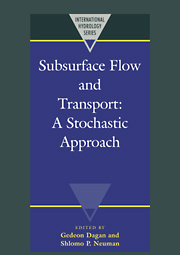Book contents
- Frontmatter
- Contents
- List of contributors
- Preface
- Acknowledgments
- I INTRODUCTION
- II SUBSURFACE CHARACTERIZATION AND PARAMETER ESTIMATION
- III FLOW MODELING AND AQUIFER MANAGEMENT
- IV TRANSPORT IN HETEROGENEOUS AQUIFERS
- 1 Transport of inert solutes by groundwater: recent developments and current issues
- 2 Transport of reactive solutes
- 3 Nonlocal reactive transport with physical and chemical heterogeneity: linear nonequilibrium sorption with random rate coefficients
- 4 Perspectives on field-scale application of stochastic subsurface hydrology
- V FRACTURED ROCKS AND UNSATURATED SOILS
- VI A VIEW TO THE FUTURE
3 - Nonlocal reactive transport with physical and chemical heterogeneity: linear nonequilibrium sorption with random rate coefficients
Published online by Cambridge University Press: 04 December 2009
- Frontmatter
- Contents
- List of contributors
- Preface
- Acknowledgments
- I INTRODUCTION
- II SUBSURFACE CHARACTERIZATION AND PARAMETER ESTIMATION
- III FLOW MODELING AND AQUIFER MANAGEMENT
- IV TRANSPORT IN HETEROGENEOUS AQUIFERS
- 1 Transport of inert solutes by groundwater: recent developments and current issues
- 2 Transport of reactive solutes
- 3 Nonlocal reactive transport with physical and chemical heterogeneity: linear nonequilibrium sorption with random rate coefficients
- 4 Perspectives on field-scale application of stochastic subsurface hydrology
- V FRACTURED ROCKS AND UNSATURATED SOILS
- VI A VIEW TO THE FUTURE
Summary
ABSTRACT A nonlocal, first-order, Eulerian, stochastic theory was developed for the mean concentration of a conservative tracer. This was extended to account for nonequilibrium linear sorption with random partition coefficient, Kd, but deterministic rate constant, Kr. Here we extend these results to account for both random Kd and Kr. The basic governing balance law for mean solution-phase concentration is nonlocal in space and time. Nonlocality is manifest in a dispersive flux, an effective convective flux and in sources and/or sinks. The mean concentration balance law is solved exactly in Fourier–Laplace space and numerically inverted to real space. Mean concentration contours and various spatial moments are presented graphically. All results simplify to earlier results under appropriate conditions. The results indicate that there are gaps in existing data sets at major reactive-chemical study sites. The model also suggests the need to design new experiments, and it further suggests that a number of novel correlation functions should be obtained.
INTRODUCTION
Our goals in this work are two-fold. First we highlight the need for nonlocality in transport theory, and secondly we extend our previous reactive transport (Hu, Deng & Cushman, 1995) model to account for both random forward and backward rate coefficients. We limit our attention here to porous media that have two natural scales: a scale on which Darcy's and Fick's laws hold locally (see Dagan, 1989; Gelhar, 1993) and a larger scale defined in terms of the integral scale of the log-fluctuating conductivity. These latter assumptions, while restrictive, are consistent with the main body of literature on transport in porous media.
Information
- Type
- Chapter
- Information
- Subsurface Flow and TransportA Stochastic Approach, pp. 146 - 156Publisher: Cambridge University PressPrint publication year: 1997
Accessibility standard: Unknown
Why this information is here
This section outlines the accessibility features of this content - including support for screen readers, full keyboard navigation and high-contrast display options. This may not be relevant for you.Accessibility Information
- 6
- Cited by
